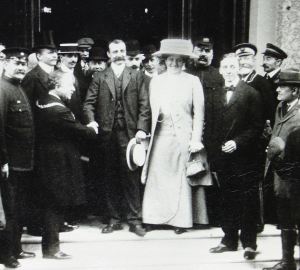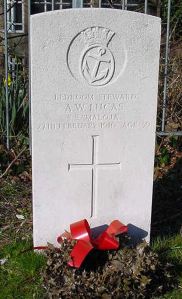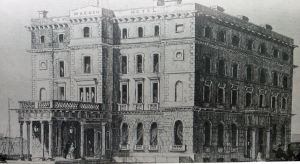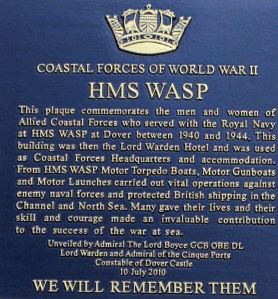In 1843, the South Eastern Railway Company purchased the land on which Lord Warden House stands for £23,500. The intention had been a splendid station together with a goods shed. Instead, due to delays and expense, when the railway was officially opened on 6 February 1844 a temporary station was used. The Directors of the company gave it the name Town Station and built a grand terminus hotel on the originally site designated for the station.
Designed by the leading theatre architect, Samuel Beazley (1786-1851), the remit was that the hotel was to look ‘magnificent from the sea, the barracks (on Western Heights and the Castle) and for passengers coming by rail.’ It was aimed at the wealthier cross-Channel travellers and originally it had 80 sleeping apartments but later refurbishments changed this to 110 bedrooms. As the Lord Warden, the Duke of Wellington (1769–1852), had been active in promoting the railway, it was seen fitting that the hotel should be named after him.
The official opening was on 7 September 1853 and was a splendid affair even though the two men everyone raised their glasses to, the Duke of Wellington and Samuel Beazley, were dead! Appointed as manager was John Birmingham, a local councillor, who had successfully run the popular Ship Hotel since 1844. He totally lived up to his excellent reputation and was revered as the ‘best known man in Europe to tourists and travellers of all classes.’
About 1861, at the time of the opening of the London, Chatham and Dover Railway Harbour Station, nearby, a covered walkway was erected to the Town Station. This was from the first floor of the Lord Warden Hotel and proved successful but was removed sometime between 1914 and 1919.
Many VIPs stayed at the Lord Warden Hotel including, in March 1871, Louis-Napoleon Bonaparte (1808–1873), known as Napoleon III, Emperor of France. It was at the Hotel where he was reunited with his wife Empress Eugenie and son after his release from Wilhelmshole Castle, Germany in March 1871. The family then retired to Chiselhurst but Napoleon died two years later. Outside Lord Warden House is a Dover Society plaque marking Napoleon III’s stay.
Charles Dickens (1812-1870) frequently stayed at the hotel and in a letter dated 1863, he made reference to John Birmingham and his wife, Mary, as ‘my much esteemed friends.‘ The nearby streets of what was then the maritime Pier District provided the atmosphere of the Tom-All-Alone’s described in, Bleak House.
William Makepeace Thackeray (1811–1863) is purported to have stayed at the Hotel on his way to and from Paris where his wife was being cared for. George Eliot, (1819–1880), was another regular customer who famously stayed in 1854 while waiting for her lover George Lewes. They then travelled to Germany for what they saw as a honeymoon even though they were not married. A much later guest, it is said, was Montague Rhodes James, (1862-1936) who was born at Goodnestone Parsonage, near Dover, and best remembered for his ghost stories published under the pen-name of M.R. James.

Louis Bleriot on the steps of the Lord Warden Hotel prior to the reception organised on his behalf, 26 July 1909. Dover Library
Louis Bleriot (1872-1936) was a guest on 25 July 1908 when he enjoyed a special luncheon to celebrate his solo flight across the Channel from France to England. Harriet Quimby, (1875-1912), stayed at the hotel before taking off from Whitfield aerodrome on 16 April 1912 to be the first woman to fly across the Channel. Sir Henry Campbell Bannerman (1836–1908), was a permanent guest prior to serving as Prime Minister from 1905-1908. In 1906, Lady Campbell Bannerman died on the Continent and on 30 August, her remains were landed at Dover before being taken to Scotland.
In 1896, Gordon Hotels took over the running of the Lord Warden, adding a new wing and refurbishing it in a grand style. They created a magnificent ballroom and dining room that was used extensively by the well to do of Dover and for civic special occasions.
On 22 January 1901 Queen Victoria died and the Crown Heads of Europe along with the nobility attended the funeral at St George’s Chapel, Windsor. During the occasion a Royal, or a member of their entourage, occupied nearly every room in the hotel. The number of guests, apparently, increased the following year for the coronation of Edward VII on 9 August 1902. This was topped by the number staying in June 1911 for the coronation of his son George V! Not long after on 4 August 1914, World War I (1914-1918) broke out and three years later in 1917, there was the Russian Revolution. During those years many of the Royalty who had attended the events and stayed at the Hotel, lost their thrones and, some, their lives.

A.W. Lucas, Bedroom Steward, Victim of the Maloja disaster, died 27 February 1916. St Mary’s Cemetery Copt Hill, Dover.
For much of the War, the Hotel had few guests except for military personnel. Lieutenant-Commander Stanley W Coxon, a member of the Dover Patrol was billeted at the Hotel. In his book, Dover During the Dark Days, he recounts the aftermath of the sinking of the P&O liner Maloja on 24 February 1916. The ship, the largest in the P&O fleet, was carrying 456 passengers and crew when she was torpedoed. 155 people drowned in the cold sea. Many of the survivors were brought to the Lord Warden and Lieutenant-Commander Coxon wrote ‘From 10 a.m. until 3 p.m. I had been disembarking the survivors and the dead and wounded of that ill-fated ship from the various crafts which had brought them alongside our pier…’
In 1917 the Admiralty fearing a raid on Dover similar to the one that was later to be carried out at a Zeebrugge by the Dover Patrol, closed the hotel. It was then sand bagged and according to one observer, ‘bristled with machine guns.’
Following the War, in 1919, the Admiralty handed the building back to Gordon Hotels who carried out a refurbishment. This was completed and opened on 7 June 1920 and in September, the rear of the Town Station was turned into a lock-up garage complete with petrol pumps. This was the second garage to open in Dover.
In September 1924 Frederick Hotels Ltd, closed the Burlington Hotel, which they owned, and took over the lease of the Lord Warden Hotel. The refurbishment this time made the interior, according to a 1930s report, look like ‘a Hollywood film set!’ Locally, it was said that the dinners and balls were magnificent and that the ballroom, with its ornamental ceilings, was a wonder. At the time, the general economy was in a major slump.
In order to visit the equally magnificent Granada Cinema in Castle Street, the ex-Queen of Spain stayed at the Lord Warden Hotel on 27 January 1933. Three years later one of the first two roundabouts to be introduced in Dover was built outside the Hotel. However, at a dinner in November 1939, following the outbreak of World War II (1939-1945), the Chairman, H Stanley Wharton, announced that, ‘This hotel is in course of being requisitioned.’
Initially the Hotel was used as a rest centre for troops on leave from France as well as by politicians and journalists. Towards the end of the Battle of Britain, on 2 September 1940, the Royal Navy requisitioned the building as the headquarters of the Coastal Force Base, HMS Wasp. The name proved an excellent deception especially when German propagandist, William Joyce alias Lord Haw Haw, stated on the radio that HMS Wasp had been torpedoed in the Channel!
Serving with the Coastal Force were members of the Royal Norwegian Navy. The forces involved were, Motor Torpedo Boats (MTBs), the heaviest boats and mainly concerned with attacking enemy ships; Motor Gun Boats (MGTs), specialised in fighting enemy light craft and Motor Launches (MLs) laid mines, took Commando Landing Parties across the Channel and rescued ‘ditched’ pilots.
The Hotel housed the administration, plotting rooms, signals section, maintenance, as well as billeting personnel while the boats, for the most part, were kept in the Camber. The WRNS who worked at HMS Wasp were billeted at Dover College, part of HMS Lynx. This was the name given to all shore base activities in Dover. When air raids threatened, if time, WRNS would cycle to the old Oil Mill caves, Limekiln Street.
During the War the Hotel was shelled but survived and HMS Wasp was decommissioned on 14 November 1944. A plaque was unveiled in the foyer to commemorate the event but has since disappeared. On 10 July 2010 Admiral Lord Boyce, the Lord Warden, unveiled another plaque on the front of the building. Again, this is to commemorate the men and women of Allied Coastal Forces who served with HMS Wasp.
On 18 September 1945, the Admiralty and the War Office handed back, to the Harbour Board, most of the harbour that they controlled from 1939 and on 30 November 1946, Dover ceased to be a naval base. Battered and badly scarred the building manage to survived the Dover’s post-war over-zealous demolition squad. The Lord Warden Hotel was officially handed back to her previous owners, Southern Railway and was scheduled for a makeover to be re-opening as a hotel. The Railway company, short of money and staff, had more pressing priorities so only essential work was carried out.
The Railway company was nationalised on 1 January 1948 becoming Southern Region. The old company continued to exist as a legal entity until 10 June 1949 when it went into voluntary liquidation. By that time the former Hotel had been renamed Southern House and was designated for offices. In 1956 the building became the regional headquarters of Customs and Excise.
Refurbishment did take place, but only as needs necessitated. On Saturday 28 November 1992, politician Roy Hattersley wrote in the Guardian that the once beautiful building ‘bears all the marks of creeping disintegration – hotel into offices into boarded-up wreck.’ Two years before Stena, the Swedish shipping group, bought Sealink, the shipping subsidiary British Rail ferries and in the deal acquired Southern House. Possibly as a reaction against Hattersley’s comments they instigated a superficial facelift for the building.
In 1998, Stena merged with P&O and Dover Harbour Board (DHB) bought Southern House for use by freight forwarding agents. The building, by then Listed, in 2007 was renamed Lord Warden House and subsequently was given a £750,000 partial makeover. At the time of writing, it is used for offices.
-
Published:
- Dover Mercury: 19 & 26 September and 3 October 2013







